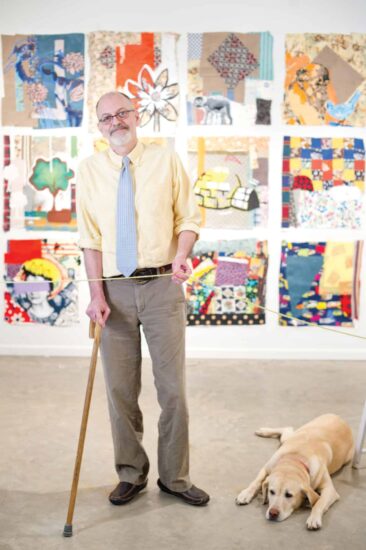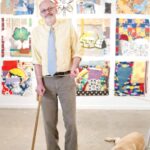Artistic Exchange

The McKinney Avenue Contemporary art gallery in Dallas recently celebrated Michael Miller's 20-year career as an influential artist, painting professor, and Director of Studio Art Graduate Studies at A&M-Commerce with a show entitled, Out of Commerce. The artists who showed alongside Miller—Trenton Doyle Hancock, Robyn O'Neil, Lawrence Lee, Daniel Kurt, and Jeff Parrot—have made a splash in the contemporary art world, but they began their journey in Miller's studio classroom. For all of his accolades and accomplishments, what comes across most in a conversation with Michael Miller is his willingness to nurture students. That does not mean hand holding or coddling—he is a little too gruff for that. Well-known for his cane and a way of barking through classes early in the semester, he can be an intimidating guy. But the intimidating exterior motivates students to do better work and Miller observes carefully and helps bring their ideas into focus as he develops relationships with his pupils. He achieves this feat not only through instruction, but by serving as a challenging mentor and sounding board.
“I was initially approached with the idea for Out of Commerce by a friend of mine – Alison de Lima Greene – curator at the Museum of Fine Arts Houston. The purpose was to run another installation of my work, but also to make a connection to students and former students who have graduated and become friends and colleagues. And that's the most rewarding thing when that happens.”
In the Classroom
It is not Miller's style to always dictate to his classes. While his assignments in foundational courses have a clear objective, as students move through the program, they gain autonomy. By the time they reach Miller's Advanced Painting class, he adopts a more hands-off approach based on practice and discussion.
“I'm not coming to the class with assignments. By the time you make it to Advanced Painting hopefully you've generated sources you're going to draw from, and that's what I want to work with. Tell me what you want to do and let's define that,” Miller said.
Trenton Doyle Hancock, alumnus and nationally-renowned artist said, “The education that he gave me and my peers, it was like we were at an Ivy League school. In fact, some Ivy League programs don't have professors of this quality. It was really amazing.”
Time in Michael Miller's classroom is a true exchange of artistic ideas. Miller learns from the experience of interacting with his students and helping them refine their vision. They influence his art as much as he influences theirs.
Miller's Art
“In my work, I collage fabric on paper and the fabric is sandwiched between two layers of matte medium, so it's enclosed in acrylic. From there I'm choosing clip art from the Internet—hundreds of images, thousands before I get to the ones I care to save. And it's not necessarily what they are but how they are. I'm interested in a gesture. One that resembles a human or something a human would do – a movement, a way of communicating with each other.”
Then students become part of the action.
“I hire students to be studio assistants – one or two at a time. The initial stages that you see here, I hire students to come in and do the collage work with fabrics and this clip art which is very straightforward. I do that also because it makes the challenge that much more interesting for me. That someone else is going to make design decisions I would never make. If I were to make them I'd somehow be thinking in the back of my mind how it's going to be solved. However, if I'm dealing with someone else's decision, I have to come up with entirely new solutions. That's the most rewarding part of having someone else, be it students or former students, take part.”
The Other Side of Michael Miller
One of the most beneficial things Miller does for his students is in offering honest critique and true insight. Despite his air of crankiness, Miller is not cruel in his assessments, but straightforward and eager to help students find their way.
“Jeff Parrot spent time at least one community college in Dallas and he was kind of allowed to do whatever he wanted to do without getting called on it. He would come into my studio and sit and we'd talk while I painted.”
Miller was blunt in confronting Parrot about his direction.
“Jeff, all this time you spent at your previous community colleges, they just kind of let you get high and make stuff, right?” Miller recalled.
When Parrot confirmed his suspicions, Miller responded, “‘Ok, that's our starting point. We are going to no longer do that and you're going to be responsible for your visual documents. You have to be able to read them first.' Thank God it made sense and he went on to a really good graduate program and the rest is history.”
As Miller instructs and guides his students, and as they exchange ideas and create art together, Miller has a tendency to become his students' biggest fan, which provides abundant motivation. His greatest gifts are helping students bring their own work into focus, helping them build confidence, and guiding them as they find their niche in the contemporary art world.
“I have several of Daniel Kurt's drawings in the house. I came upon one in his early portfolio, and I told him what I was reading in terms of the narrative. I told him I thought he should give it to me. Another student said I should buy it. So I said, ‘I'll give you all the money in my wallet right now.' To both of our surprises there was a lot more money in my wallet than I thought. It was a deal. I got the drawing and he got my wallet, and I'm very happy to have it.”



